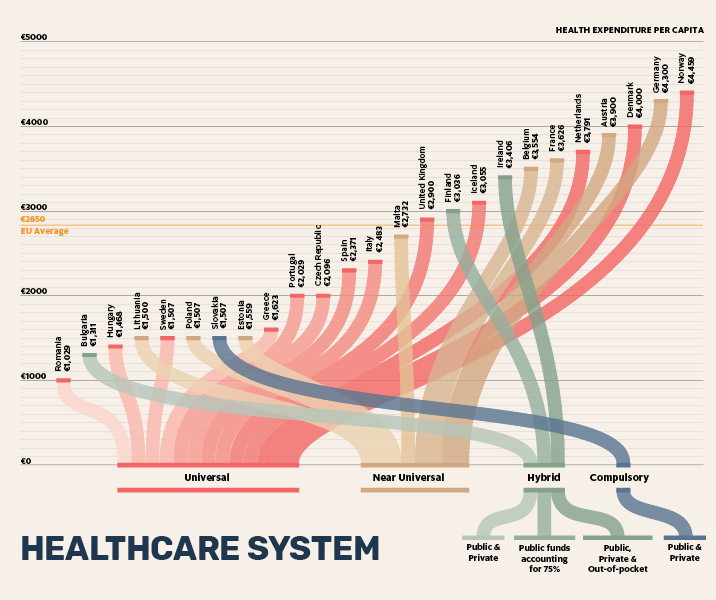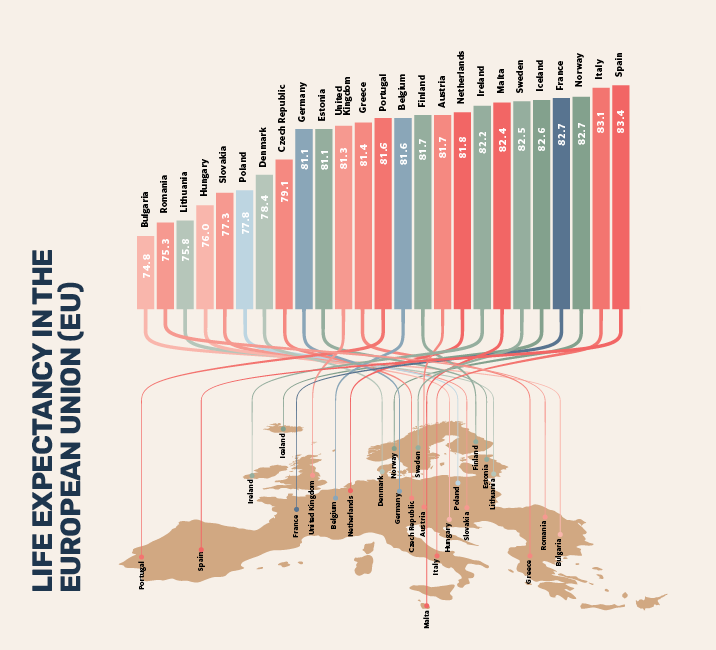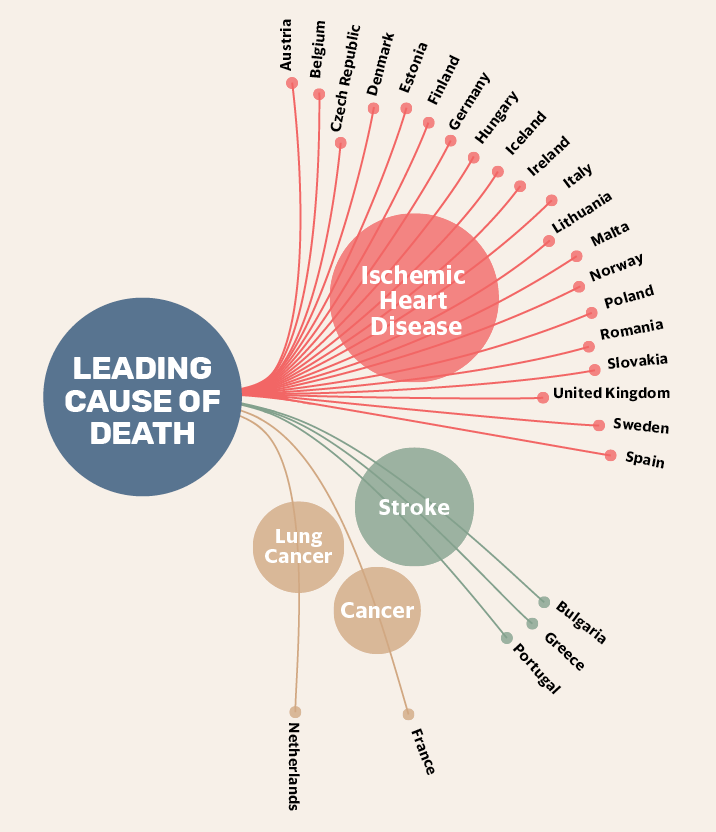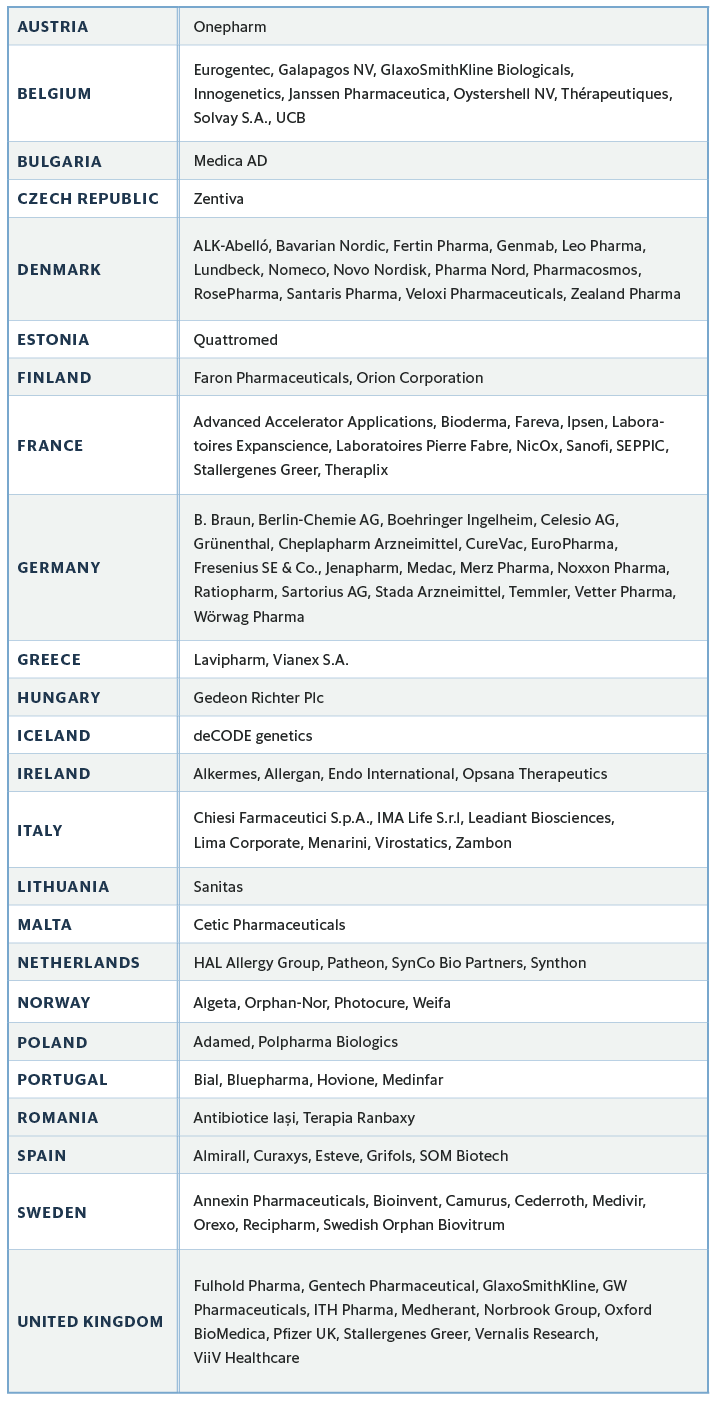March 19, 2020 PAP-Q1-20-NI-005
Health Status
About 70% of Austrians report good health, but this proportion is smaller among the lowest income groups. Risk factors include poor diet, smoking, and alcohol consumption. While Austrians are living longer, more of those years are lived with diseases and disabilities than the EU average.
Key Notes
Decentralized decision-making and self-governance by corporate entities characterize the overall healthcare system. A wave of physician retirements and a stagnant number of physicians with social health insurance contracts may reduce service availability and accessibility in the future.
Health Status
While life expectancy has risen by almost four years since the year 2000, there still remains a five-year disparity between the most educated and the least educated citizens. Risk factors include binge drinking and growing rates of obesity. Tobacco use has declined by 6% over the past decade.
Key Notes
Access to healthcare is relatively good, as service coverage is broad, but user charges apply for most services. Although the number of doctors has increased slowly over the past 15 years, 45% of doctors are now over age 55, raising concerns about physician shortages in the future.
Health Status
Life expectancy increased by more than three years between 2000 and 2017, but there are significant disparities in health status across gender, region, and educational lines. Morbidity from infectious diseases like tuberculosis is an ongoing concern. Risk factors include smoking, with tobacco consumption being the highest in the EU at 28%. Childhood obesity is also on the rise.
Key Notes
Bulgaria has the lowest life expectancy in the EU. The implementation of primary prevention and health promotion is weak, as indicated by a high rate of preventable mortality. Out-of-pocket spending is a key barrier to healthcare access, comprising 47% of total health expenditure. Approximately 14% of the population is uninsured, and shortages of healthcare professionals are hindering development of primary care.
Health Status
Life expectancy increased by four years between 2000 and 2017, but still remains two years below the EU average. Risk factors include poor diet and low physical activity, resulting in an obesity rate of 20%. Smoking is on the decline, but alcohol consumption is approximately 1.7 liters more per person than the EU average.
Key Notes
Few Czech citizens report unmet medical care needs, and universal coverage is guaranteed. Although life expectancy is two years below the EU average, strides have been made in reducing mortality from ischemic heart disease, stroke, and several types of cancer.

Health Status
Life expectancy has increased by over four years since the year 2000, primarily linked to reductions in certain risk factors like smoking. Obesity is on the rise, and while smoking and drinking rates have declined, they still remain above EU averages.
Key Notes
The Danish health system has a first-rate information infrastructure, including an electronic medical record system that is used across the entire healthcare system. The government has also taken measures to ensure timely access to new medicines while simultaneously controlling the growth of drug prices. Behavioral risk factors account for more than 40% of all deaths in Denmark.
Health Status
Life expectancy has increased more in Estonia than in any other EU country, but risk factors include heavy alcohol consumption (nearly twice the EU average) and rising obesity. Women live nine years longer than men on average.
Key Notes
While Estonia has achieved the greatest gains in life expectancy of any country in the EU since 2000, there is still a disparity across gender, region, income, and levels of education. Three out of four Estonians in the highest income quintile consider themselves in good health, while only one in three in the lowest feel the same way, which is the greatest gap in the EU.
Health Status
Life expectancy has increased by nearly four years since the year 2000; however, due to more activity limitations than other EU countries, they experience a lower number of healthy life years. Risk factors include heavy episodic alcohol consumption and rising obesity.
Key Notes
Healthcare funded by employers and primary care provided through private providers facilitate faster access for people from higher socioeconomic demographics, while retirees and people from lower socioeconomic classes have to wait longer for care.
Health Status
Life expectancy is about two years higher than the EU average and third highest in the EU behind Spain and Italy. Risk factors include smoking (25% of adults are daily smokers), alcohol consumption (20% higher than EU average), and rising obesity (14%).
Key Notes
Many years after age 65 are spent with chronic diseases and disabilities. To combat this, the French government allocated €400 million over five years to support prevention programs aimed at improving nutrition, reducing smoking and alcohol consumption, and reducing obesity.
Health Status
While life expectancy slightly exceeds the EU average, it is increasing at a slower rate than other EU countries. Risk factors include poor diet, smoking, and alcohol consumption, with binge drinking (20%) and obesity (16%) rates exceeding those in many EU countries.
Key Notes
Broad social health insurance benefits enable Germans to access healthcare generally without any financial limitations and with few disparities between socioeconomic classes. Germany has a higher number of doctors and nurses than many EU countries, but rural regions have far less access than cities.
Health Status
Some inequalities in health across gender and social status exist, and people ages 65 and older can expect to live only 40% of their life free of disability. Some forms of cancer, diabetes, and infant mortality are on the rise. Risk factors include smoking, obesity, and sedentary lifestyle.
Key Notes
Legislation in 2016 succeeded in re-establishing health coverage for the two million people who lost health insurance during the economic crisis. Despite this, one in ten households experiences catastrophic payments for healthcare.
Health Status
Life expectancy is lower than in most EU countries, and disparities across gender and socioeconomic groups are substantial. Behavioral risk factors account for half of all deaths and include smoking (over 25%) and obesity (25%), which are among the highest rates in the EU.
Key Notes
The Hungarian health system is highly centralized, as it is organized around a single insurance fund. The benefit package is less comprehensive than in most EU countries, resulting in high out-of-pocket costs, over half of which are going toward pharmaceuticals and medical devices. Primary care has yet to play a prominent role in this hospital-centric country.
Health Status
Life expectancy has increased by nearly three years since 2000 and is almost two years above the EU average. Primary risk factor is obesity at 27%, which is higher than any EU country.
Key Notes
Tobacco and alcohol consumption are substantially lower than in most other EU countries due to a longstanding and comprehensive effort to combat their use. To combat childhood obesity, Iceland has begun issuing guidelines on nutrition and physical activity, as well as restricting marketing of certain foods toward children.
Health Status
Life expectancy has increased by nearly six years since 2000, the strongest of all Western European countries. The increase can be attributed to improved treatments and reduction in smoking. Alcohol consumption (33%) and obesity (18%) are both well above the EU averages.
Key Notes
Ireland is the only Western European country without universal or near universal coverage for primary care. Private health insurance is widespread, and inequitable access among socioeconomic groups is high, resulting in longer than normal treatment wait times compared with other Western European countries.
Health Status
Life expectancy is the second highest in the EU after Spain. People living in the most affluent regions in the north live over three years longer than those living in the least affluent regions in the south. Risk factors include smoking (20%) and obesity (11%).
Key Notes
The health of the Italian population is generally good, and following the economic crisis in 2008, health spending has stabilized. Inadequate vaccination coverage has led to several measles outbreaks in recent years, leading to a national vaccination plan for ten mandatory vaccines for children.
Health Status
Health outcomes are among the worst in the EU. The gender gap in life expectancy is almost double the EU average. Behavioral risk factors account for more than half of deaths, with over one in three men smoking on a daily basis and an obesity rate over 17%.
Key Notes
Mental health is a key public issue, as Lithuania has the highest suicide rate in the EU. Containment of infectious diseases like tuberculosis and measles has also been a persistent challenge. A centralized, underfunded, single-insurance fund covers 98% of the population, with high out-of-pocket costs mainly going toward pharmaceuticals.

Health Status
Maltese life expectancy has increased by four years since 2000, largely attributable to declining mortality from some forms of treatable cancers. Risk factors include one of the highest obesity rates in the EU at over 25% for adults and 33% for 15-year-olds.
Key Notes
As a small country, Malta faces challenges in securing new medicines. This is now a critical issue, with the government’s list of approved medicines struggling to keep up with innovation. New public capital investment has been made to upgrade medical equipment in hospitals and to build additional hospital units.
Health Status
Life expectancy at birth is higher than the EU average, but gains in life expectancy have stalled due to an increase in mortality rates among the very old. Risk factors like smoking, alcohol consumption, and obesity are all below the EU averages.
Key Notes
Low mortality rates from preventable and treatable causes indicate that the Dutch health system provides effective public health and healthcare education and intervention. Access to healthcare is generally good, with no real disparities among socioeconomic groups as it pertains to unmet needs.
Health Status
Life expectancy increased nearly four years since 2004, driven by a reduction in deaths from cardiovascular diseases. Risk factors like smoking have decreased substantially (11%, down from 32% in 2000) and are now among the lowest in the EU.
Key Notes
Norwegians have a healthier lifestyle than people from most other countries in the EU. Their generally low alcohol consumption and low obesity rates, and successful anti-smoking initiatives, contribute to the overall good health status and high life expectancy of the population. Survival rates are well above the EU average for many types of cancers.
Health Status
Life expectancy has climbed over three years since 2000, with behavioral risk factors accounting for over half of all deaths. However, smoking, alcohol consumption, and obesity rates all fall below EU averages.
Key Notes
Out-of-pocket spending is comparatively high, at nearly 23% of the total health expenditure — this is mostly attributable to pharmaceutical costs. Over half of adults over the age of 65 report symptoms of depression, compared with only 20% across the EU. Mortality from treatable causes continues to be much higher than the EU average and survival rates for cancers are consistently lower than in the EU overall.
Health Status
Life expectancy is growing, up nearly four years since 2000, but people are also living with chronic disabilities and diseases. Risk factors include smoking (17%) and poor diet, while alcohol consumption and obesity are below the EU averages.
Key Notes
On average, women live six years longer than men, which is well above the EU average. Levels of physical activity are also low compared with the EU average. However, Portugal has a strong primary care system, which manages to keep patients out of the hospital when appropriate.
Health Status
Large disparities in life expectancy by gender and education level. Highest rate of tuberculosis cases in the EU. Risk factors include smoking (20%) and alcohol consumption, with binge drinking rates exceeding 35%.
Key Notes
Life expectancy in Romania is among the lowest in the EU. Health spending is historically low and less than any other EU country, both per capita and in proportion of GDP. The system is incapable of meeting the population needs, and the number of doctors and nurses is among the lowest in Europe.

Health Status
Life expectancy has risen by four years since 2000, but still remains nearly four years below the EU average. The main risk factor is smoking (25%), which, unlike in most EU countries, has not decreased over the last decade.
Key Notes
The most educated men live 14 years longer than the least educated men. The healthcare system is hospital-centric, and Slovakia has yet to prioritize primary care. Doctors are unevenly spread throughout the country, limiting access to the population as a whole. Health spending in Slovakia is much lower than most EU countries, at 6.7% of GDP compared with 9.8% in the EU.
Health Status
Life expectancy has increased by four years since 2000, and Spain has the highest life expectancy of any EU country. Risk factors include smoking (22%) and obesity (17%), but heavy alcohol consumption is among the lowest in Europe (9%).
Key Notes
Following the economic crisis, healthcare spending decreased for several years, but started to increase again in 2015. Primary care remains a central element of the Spanish health system, with general practitioners and nurses providing care for the entire population, as well as preventive and health promotion services targeting children, women, and elderly people.
Health Status
While stroke and other cardiovascular diseases are decreasing as causes of death in Sweden, an increased number of people are dying from Alzheimer’s disease and other dementias. Risk factors are on the decline, as smoking decreased from 19% in 2000 to 10% in 2017. Alcohol consumption and obesity are around the EU averages.
Key Notes
Sweden spends a large amount of money on healthcare, both with spending per capita and as a proportion of GDP — the third highest among EU countries. However, most of its spending is in the form of outpatient and long-term care, as opposed to hospitalization.
Health Status
Disparities in health status are apparent when observing that people with higher levels of education live four years longer than those with the lowest level. The primary risk factor is obesity, at about 20%, while smoking and alcohol consumption continue to decrease.
Key Notes
The four nations of the United Kingdom all have tax-funded health systems that provide universal access to a comprehensive benefit package. In general, there are low levels of unmet needs, minimal out-of-pocket spending, and good financial protection. Most impressively, this is achieved with average levels of health spending when compared to other EU countries.


Nice Insight, established in 2010, is the research division of That’s Nice, A Science Agency, providing data and analysis from proprietary annual surveys, custom primary qualitative and quantitative research as well as extensive secondary research. Current annual surveys include The Nice Insight Contract Development & Manufacturing (CDMO/CMO), Survey The Nice Insight Contract Research - Preclinical and Clinical (CRO) Survey, The Nice Insight Pharmaceutical Equipment Survey, and The Nice Insight Pharmaceutical Excipients Survey.